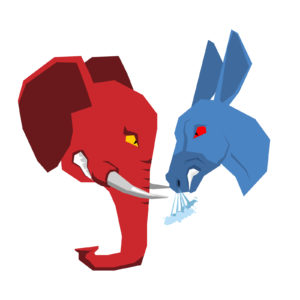As Democratic candidates take the stage for the 2020 presidential election, and political ideology labels are brandished upon them, such as who has leaped too far left and, of course, anyone from the Republican Party gets the obligatory label alt-right, it is time to consider a new rendition of political ideology labels in the United States.
The traditional rendition describes politicians along a line moving to the left or right from the ever-changing, but agnostic, “moderate” positions. Movement from the center is a spectrum in which the further people move away from the center the more they are in opposition to the “other side,” and the more opponents will describe the politician, citizen or group as extreme. This is not an accurate conceptual model to show how far one is from our founding American political ideology.
Consider first that the “center” of the line not be labeled “moderate.” Think of the center as our founding American ideology, such as recognizing our inalienable rights given from Natural Law, consent of the governed, limited government, appreciating Federalism, respect for the rule of law, primacy of one’s property, respect for one’s labor, and a free market enterprise.
Second, consider that labels given to people should not be based on what they say or what they write, but how they act. Thinking as the American pragmatist philosopher Charles Sanders Peirce (1839-1914), meaning is drawn from our public acts, not from what we think.
Next, envision the political ideology labels not along a line but more like an arch. People’s actions moving away from our founding American ideology are arching. Those furthest away from either the left or right don’t actually touch but look alike by their actions, which are counter to our founding American values.
To illustrate, examine the actions of an alt-right group, Klu Klux Klan. In addition, examine the actions of today’s alt-left group Antifa. They are not opposites on a linear spectrum but actually very close and similar as each is arching away from our American ideology.
How are they similar? Both have an abject and irrational hate for a group of people. Both claim to be “speaking” for a larger group in society than the reality. They go out of their own station in life to disguise themselves, while causing harm. They are generally mute. Both meet in private and don’t want to be identified. They are actually small in number; but the media choose which group they will give attention to, either to make them larger than life or insignificant. Both claim to be “patriots,” of a sort. They long for a society that is not based in reality for what America stands for, e.g. there is no one superior race and there is no utopia. Both cover their faces to do their deeds. They both act cowardly.
Threats to the American Spirit and America’s founding principles are not just threatened by these extremes, but are at risk from other ideologies and acts that move away from the values of civic republicanism. In this new rendition, the American Ideology is the authentic political space. Slogans such as “My country love it or leave it” or being dismissive of America’s founding principles because they were “developed by a bunch of dead white guys” do not comport with the American Spirit, nor do these comport with who we should be as a civil people living in a land guided by the U.S. Constitution.
Arching off to the left or to the right dilutes, and if too extreme poisons, the American Spirit and the founding principles of our country.

